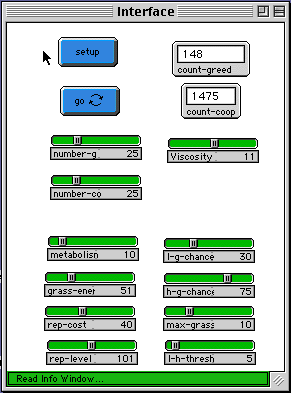
WHAT IS IT? ----------- This is an evolutionary biology model. In it, different breeds of cows compete for natural resources. Individuals that are more successful in getting the resources will reproduces more often, and will thus be more evolutionarily successful. There are two breeds of agents: greedy and cooperative cows. Every turn, each cow looks at the patch that it is currently on, and eats a unit of grass. The greedy cows eat the grass regardless of the length of the grass on the current patch. The cooperative cows won't eat the grass below a certain height. This behavior is significant because below a certain height (called the 'growth threshold') the grass grows at a far slower rate than above it. Thus, the cooperative agents leave more food for the overall population at a cost to their individual well-being, while the greedy agents eat the grass down to the nub, regardless of the effect on the overall population. HOW TO USE IT? -------------- GO: Starts and stops the model. SETUP: Resets the simulation according to the parameters set by the sliders. NUMBER-G: Sets the number of greedy cows. NUMBER-COOP: Sets the number of cooperative cows. VISCOSITY: This value determines the limitations on the movement of the cows. At a value of 0 or 1, each cow moves forward 1 each turn. As the value is increased, the cows are limited to a fraction of their movement. This value is the denominator of that fraction; thus, the higher the viscosity, the less the mobility of the cows. The term 'viscosity' derives from imagining a thick or viscous fluid as the medium through which the agents must move. GRASS-ENERGY: Each time a cow can each some grass from the patch that it currently occupies, it increases its energy by the value of this slider. METABOLISM: Every turn, each cow loses the amount of energy set by this slider. If the cows energy reaches 0, it dies. Every cow starts with a default energy of 50, which means it can go five turns without eating. REP-LEVEL: If a cow's energy reaches the value of this slider, it reproduces. This value represents the food-gathering success that a cow would have to have in order to be able to reproduce. REP-COST: Each time a cow reproduces, it loses the amount of energy set by this slider. This value represents the energy cost of reproduction. L-G-CHANCE: This value is the percentage chance that the grass below the growth threshold will grow back. The higher this value, the less the descrepancy between the behaviors of the cooperative and greedy cows. H-G-CHANCE: This value is the percentage chance that the grass above the growth threshold will grow back. The lower this value, the less the descrepancy between the behaviors of the cooperative and greedy cows. MAX-GRASS: This value sets the highest length to which the grass can grow. L-H-THRESH: This value sets the growth threshold. At, or above this value, the grass grows back with H-G-CHANCE. Beclow this value, the grass grows back with L-G-CHANCE. THINGS TO NOTICE ---------------- Using the default settings, notice how the greedy (blue) cows quickly take over the world. Look at the number of cooperative versus greedy agents. Also, look at the different growth habits on the graph. Which population expanded first? THINGS TO TRY ------------- Slowly increase the VISCOSITY slider. What happens to the graph? What happens to the populations? At what value of VISCOSITY do the populations' growth rates change dramatically? What does this indicate about the evolutionary advantages of Cooperating versus being Greedy? What are the important environmental factors? Change the METABOLISM and the GRASS-ENGERY values. How do these values affect the model? Change the L-G-CHANCE and the H-G-CHANCE values. How do these values affect the model? How does the L-H-THRESH value affect the growth of the populations? EXTENDING THE MODEL ------------------- This model explores only one type of cooperative behavior, namely eating the grass above the growth threshold (the L-H-THRESH value). What other cooperative, or altruistic, behaviors could be modeled that hurt individual fitness, while helping the group overall? What other environmental conditions than grass length could be used to effect the health of a population? This model relies primarily upon population viscosity (the VISCOSITY slider) to alter the behavior of the cows to allow for the success of the cooperative agents. What other variables could have such a drastic effect on the evolutionary success of populations? Also, consider that in this model the behaviors are fixed. What would happen if the agents learned, or changed their behavior based on food availability? RELATED MODELS -------------- Altruism (Trait) Model